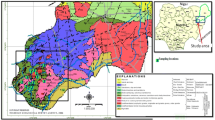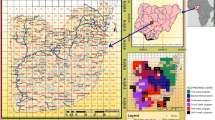Abstract
Radon levels were surveyed in 517 monitoring wells constructed in five major groundwater areas of Taiwan. The radon concentration in groundwater samples varied in a wide range from below the detection limit of 18 pCi/L up to 1,100 pCi/L. A worldwide comparison of reported groundwater radon levels was conducted. Overall radon levels in Taiwan groundwater are relatively low compared to other countries because the geology of Taiwan is mainly comprised of sedimentary rocks. Among the 517 wells monitored, only five wells were found with radon concentrations higher than 500 pCi/L. These five wells are all located near the Chaochou Fault in the Pingtung Plain. This study suggests that well sites near the Chaochou Fault could be good locations to monitor radon anomalies for earthquake prediction and should be avoided for developing domestic water supply. In the recharge area near the Chaochou Fault, the radon concentration in groundwater from shallow wells was approximately 1/2 to 1/4 of that from deep wells in the same cluster.
Resumen
Se investigaron los niveles de radón en 517 pozos de monitoreo, construidos en las cinco mayores áreas de agua subterránea de Taiwan. La concentración de radón en las muestras de agua subterránea varía en un rango amplio, desde inferior al límite de detección que es 18 pCi/L hasta 1,100 pCi/L. Se realizó una comparación a escala mundial de los niveles de radón reportados en agua subterránea. En general los niveles de radón presente en el agua subterránea de Taiwan, son relativamente bajos comparados con otros países, puesto que la geología de Taiwan está compuesta de rocas sedimentarias. Entre los 517 pozos monitoreados, solamente en cinco se encontraron concentraciones de radón mayores a 500 pCi/L. Estos cinco pozos están todos localizados cerca de la falla ChaoChou en la Planicie de PingTung. El presente estudio sugiere que los pozos cercanos a la falla Chaochou, podrían ser buenos sitios para monitorear anomalías de radón para la predicción de terremotos y deberían evitarse para los desarrollos de abastecimiento de agua potable. En la zona de recarga cerca de la falla Chaochou, la concentración de radón en agua subterránea obtenida en pozos someros, fue aproximadamente de ½ a ¼ de aquella en pozos profundos ubicados en el mismo sector.
Résumé
On a mesuré les taux de Rn dans 517 forages ouverts dans cinq aquifères majeures de Taiwan. Les concentrations en Rn couvrent un domaine très large, à partir de valeurs très basses, au dessous de la limite de détection de 18pCi/l jusqu’aux valeurs assez grandes de 1100pCi/l. On a mené une analyse comparative avec des valeurs mentionnées en littérature. Par report aux valeurs mesurées en autres pays, les concentrations en Rn en Taiwan sont asses basses, compte que la structure géologique de Taiwan est constituée surtout par des roches sedimentaires. On a trouvé des concentrations au desuss de 500pCi/l seulement en cinq de 517 forages investigués. Tous ces cinq forages se trouvent au voisinage de la faille de Chaochou dans la plaine de Pingtung. Cet étude suggere que les forages situés près de la faille de Chaochou peuvent bien monitoriser les anomalie de Rn pour la prédiction des séismes mais doivent être évités lorsq’il s’agit de l’alimentation en eau potable. Dans la zone de recharge près de la faille de Chaochou les concentrations en Rn mesurées dans les puits peu profondes representent 1/2-1/4 de ceux mesurées dans les forages de profondeur.










Similar content being viewed by others
References
Alabdula’aly AI (1996) Occurrence of radon in Riyadh groundwater supplies. Health Physics 70(1):103–108
Alabdula’aly AI (1999) Occurrence of radon in the central region groundwater of Saudi Arabia. Journal of Environmental Radioactivity 44(1):85–95
Asikainen M, Kahlos H (1980) Natural radioactivity of drinking water in Finland. Health Physics 39(1):77–38
Banks D, Frengstad B, Midtgård AK, Krog JR, Strand T (1998a) The chemistry of Norwegian groundwaters: I. The distribution of radon, major and minor elements in 1604 crystalline bedrock groundwaters. The Science of the Total Environment 222(1–2):71–91
Banks D, Midtgård AK, Frengstad B, Krog JR, Strand T (1998b) The chemistry of Norwegian groundwaters: II. The chemistry of 72 groundwaters from Quaternary sedimentary aquifers. The Science of the Total Environment 222(1–2):93–105
Brutsaert WF, Norton SA, Hess CT, Williams JS (1981) Geologic and hydrologic factors controlling radon-222 in ground water in Maine. Ground Water 19(4):407–417
Cech I, Kreitler C, Prichard H, Holguin A, Lemma M (1988) Radon distribution in domestic water of Texas. Ground Water 26(5):561–569
Dixon KL, Lee RG (1988) Occurrence of radon in well supplies. Journal American Water Works Association 80(7):65–70
Freyer K, Treutler HC, Dehnert J, Nestler W (1997) Sampling and measurement of radon-222 in water. Journal of Environmental Radioactivity 37(3):327–337
Han YL, Kuo MCT (2003) Monitoring of radon in Taiwan groundwaters. 2nd Taiwan-Japan International Workshop on Hydrological and Geochemical Research for Earthquake Prediction, Tainan, Taiwan, pp 69–71
Hess CT, Michel J, Horton TR, Prichard HM, Coniglio WA (1985) The occurrence of radioactivity in public water supplies in the United States. Health Physics 48(5):553–586
Igarashi G, Saeki S, Takahata N, Sumikawa K, Tasaka S, Sasaki Y, Takahashi M, Sano Y (1995) Ground-water radon anomaly before the Kobe earthquake in Japan. Science 269:60–61
King CY (1978) Radon emanation on San Andreas Fault. Nature (London) 271:516–519
King PT, Michel J, Moore WS (1982) Ground water geochemistry of 228Ra, 226Ra and 222Rn. Geochimica et Cosmochimica Acta 46:1173–1182
Lin YM, Chen CC (1983) Monitoring of radon in water of Taiwan. Hoken Butsuri 18:23–27
Lin YM, Lin PH, Huang CC, Chen CJ, Chu TC (1986) Investigation of natural radionuclides in rocks of Taiwan. Nucl Sci J 23(2):138–142
Liu KK, Yeh YH, Teng TL (1986) Ground-water radon variation associated with the May 20, 1986 Hualien, Taiwan earthquake. Bulletin of the Institute of Earth Sciences, Academia Sinica (6):85–94
Longtin JP (1988) Occurrence of radon, radium, and uranium in groundwater. Journal American Water Works Association 80(7):84–93
Loomis DP (1987) Radon-222 concentration and aquifer lithology in North Carolina. Ground Water Monitoring Review 7(2):33–39
Lowry JD (1991) Measuring low radon levels in drinking water supplies. Journal American Water Works Association (4):149–153
Noguchi M (1964) Radioactivity measurement of radon by means of liquid scintillation fluid. Radioisotope 13(5):362–366
Noguchi M, Wakita H (1977) A method for continuous measurement of radon in groundwater for earthquake prediction. Journal of Geophysical Research 82:1353–1357
Otwoma D, Mustapha AO (1998) Measurement of 222Rn concentration in Kenyan groundwater. Health Physics 74(1):91–95
Prichard HM, Gesell TF (1977). Rapid measurements of 222Rn concentrations in water with a commercial liquid scintillation counter. Health Physics 33:577–581
Prichard HM, Venso EA, Dodson CL (1992) Liquid-Scintillation analysis of 222Rn in water by alpha-beta discrimination. Journal of Radioactivity and Radiochemistry 3(1):28–36
Sabol J, Weng PS, Mao CH (1995). Monitoring of 222Rn in Taiwanese hot spring spa waters using a modified electret ion chamber method. Health Physics 68(1):100–104
Sasser MK, Watson JE (1978) An evaluation of the radon concentration in North Carolina ground water supplies. Health Physics 34:667–671
Soto J, Fernández PL, Quindós LS, Gómez-Arozamena J (1995a) Radioactivity in Spanish spas. The Science of the Total Environment 162:187–192
Soto J, Fernández PL, Gómez J, Ródenas C (1995b) Study of the occurrence of 222Rn and 226Ra in drinking water in Spain. Health Physics 69(6):961–965
United Nations Scientific Committee on the Effects of Atomic Radiation (1988) Sources, Effects and Risks of Ionizing Radiation. Report to the General Assembly, United Nations, New York, pp 24–79
Acknowledgements
The support of the Water Resources Agency and Energy Commission of the Ministry of Economic Affairs, and the National Science Council of Taiwan is appreciated.
Author information
Authors and Affiliations
Corresponding author
Rights and permissions
About this article
Cite this article
Han, Y.L., Tom Kuo, M.C., Fan, K.C. et al. Radon distribution in groundwater of Taiwan. Hydrogeol J 14, 173–179 (2006). https://doi.org/10.1007/s10040-004-0384-7
Received:
Accepted:
Published:
Issue Date:
DOI: https://doi.org/10.1007/s10040-004-0384-7




